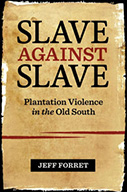Slave Against Slave: Plantation Violence In The Old South

Author: Jeff Forret
Baton Rouge: Louisiana State University Press, 2015. 544p.
Reviewer: David Anderson | July 2017
Over the last two decades, several scholars, including Brenda E. Stevenson, Christopher Morris, Dylan C. Penningroth, and Anthony E. Kaye, have focused attention on instances of fracture and fragmentation within the antebellum slave community, adding critical voices to conversations about tensions engendered by the system of slavery. One facet of this critical turn has sought to complicate simplistic assumptions about communal solidarity among the South’s enslaved population, and question central ideas regarding slave agency, recalibrating prevailing narratives of slave life encapsulated by John W. Blassingame’s The Slave Community (1972) within extant studies of American slavery. Jeff Forret’s analysis of violent encounters and conflicts between the enslaved, which seeks to “capture the emotional intensity and complexity of life under bondage” (7), should occupy an important place in this larger field of inquiry.
Forret’s research is exhaustive. Drawing on an impressive array of sources, including county and state court papers, church records, slave narratives and autobiographies, travelers’ accounts, newspapers, and slaveholder diaries and journals, Forret exposes the slave community as a “contested arena of negotiation,” where enslaved men and women “employed violence to create, maintain, or dissolve social ties” (26). More than a signal to destructive acts, violence, argues Forret, “could play a constructive role” in the slave community, affording the enslaved “an avenue through which to uphold cultural expectations, police themselves internally without interference from whites, and impose a moral and ethical code of their own creation” (25).
Paying particular attention to the Virginia Piedmont, the South Carolina upcountry, Middle Georgia, and Adams County, Mississippi, as well as a small sample of urban areas, the author traces the pervasiveness of slave-on-slave violence from aboard the slave ships that transported shackled captives across the Atlantic through the post-Revolutionary period to emancipation and the final months of the Civil War.
Forret pursues his theme across eight chapters, focussing on clashes, physical and otherwise, arising from slaves’ habitual work-time and leisure activities, as well as matters of property, family, and acts of honour as likely motivations for slaves’ disputes and disagreements with one another. “The causes of violence were sometimes multiple, overlapping, and difficult to disentangle,” concedes Forret (19). While the precise frequency of intra-racial slave violence, encompassing fatal and non-fatal encounters, is impossible to know, Forret’s carefully constructed database on convictions of slave-slave murders in Virginia between 1774 and 1864 allows him to identify a number of interesting trends and patterns across gender, geographical, and temporal lines.
Weaving together analysis of societal reactions to the violence that erupted among bond people, Forret demonstrates that masters and overseers struggled to rid the quarters of violent outbreaks, often dispensing their own forms of plantation justice (usually whipping or incarceration in stocks or chains) rather than resort to the more formal southern judicial system. However, his attention to state laws, legal reports, legislative journals, and petitions reveals the South’s criminal court systems frequently adjudicated on intra-racial slave violence, pointing out that trial procedures and possible punishments varied widely across the slaveholding states. Mining Baptist church records, Forret also describes how enslaved churchgoers were subject to disciplinary measures. Scholars who are interested in academic work on enslaved masculinity and femininity will welcome the author’s analysis of the gendered nature of violence in the quarters which opens up critical space for inquiring into the construction and maintenance of self and family identities within the slave community and wider white society.
In a brief epilogue, Forret leaps from past to present, and examines how intra-racial slave violence might inform and frame current-day debates focused on violence among African- Americans. By historicizing the social construction of black-on-black violence, Forret looks to nuance a persistent inclination to view “an unbroken line linking the intra-racial violence among blacks during bondage and that of modern times,” offering a valuable corrective to this tendency by challenging assumptions that “contemporary ‘black-on-black violence’ may be explained as the residual aftereffect of slavery” (394). Questioning portraits of slavery that perpetuate “a peculiarly harmonious slave community,” Slave against Slave captures the violent rages, rants, and resentments of enslaved men and women, an aspect of everyday interactions and relationships in the quarters that has not had the attention it deserves, to reveal “the full range of human emotion” among bond people, asking us to think afresh about our understanding of the slaveholding South and slave life (394). Many future studies are sure to build on Jeff Forret’s significant intervention into the internal dynamics of the slave community.
David Anderson, Senior Lecturer, American Studies, Swansea University


